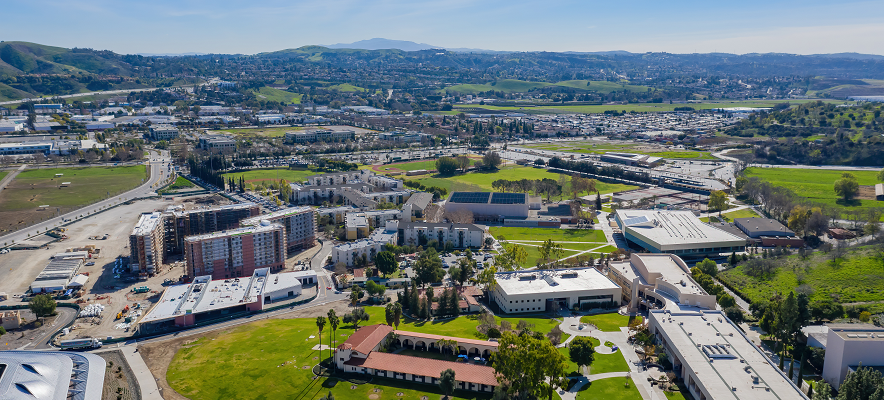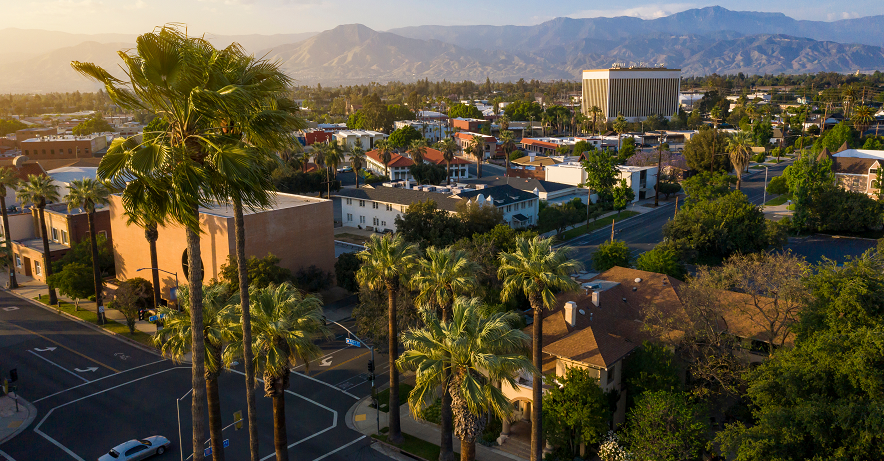Share this article:
Student life is an exciting combination of the school you go to, the friendships you make and the place you move to. So, for the second report in our Best College Towns series, we’re looking at the best college towns in California to discover the places where students can enjoy their college years to the max. In this case, San Luis Obispo topped the list of best college towns in California, followed by Arcata and Berkeley.
Best College Towns in California
To create the ranking, we analyzed 22 California towns in terms of affordability, livability and quality of education with each category defined by relevant metrics. In total, we considered data for 13 metrics across the three categories.
Specifically, the affordability category took into account tuition fees, grants, scholarships and cost of living with the maximum score for affordability being 35. Next, to assess livability, we analyzed the availability of arts, entertainment, recreation, natural amenities, air quality and demographic characteristics for a maximum score of 30. Meanwhile, the education category included the university’s U.S. News & World Report ranking, student-to-faculty ratio, graduation rate, admissions stats and retention rates for a total possible score of 35. Finally, we also asked professors, admissions officers, and students from various universities in this ranking to share their opinions on what mattered when choosing a specific university and college town to live in.
These are the top 10 college towns in California:
1. San Luis Obispo, CA

The top-ranking college town in California is San Luis Obispo, home to California Polytechnic State University. Cal Poly was named by U.S. News & World Report as the top public regional university in the West, contributing to the city’s high score in the education category. What’s more, the university also boasts a big and beautiful campus — the second-largest in California. Out of a population of around 47,000, 33% are students in San Luis Obispo.
The town also ranked high in affordability, thus offering the best mix of quality education and cost, which earned it the top spot in the ranking.
San Luis Obispo is a charming town full of history and hospitality. Advertising a slower pace of life, SLO is surrounded by beautiful state parks, while the nearby San Luis Obispo Bay is where locals can enjoy a day at the beach.
2. Arcata, CA
Arcata took the second spot in our ranking of best college towns in California, coming in first in affordability and second in livability. It’s home to the Humboldt campus of the California State University system, which had one of the lowest tuition fees in our ranking. Plus, of the students enrolled at this college, 75% receive some form of grant, scholarship or financial aid, which helps them live in Arcata comfortably.
The Humboldt campus was founded in 1913. Since then, it’s carried out a tradition of high-value education in small classes where students and teachers can build a good relationship that facilitates individual learning.
In terms of livability, Arcata ranked second, being home to the third-highest percentage of young adults (35%). Located in the northern part of the state, Arcata is close to Humboldt Bay, so residents enjoy an oceanic climate with summers in the city being cooler than in other areas. The campus is also located in a beautiful area surrounded by mountains, beaches and ancient redwoods, which is why it has the highest natural amenity scale out of all of the towns in our ranking.
3. Berkeley, CA

Home to the University of California’s oldest campus, Berkeley ranked as the third overall best college town in California after finishing fourth in both livability and education. In terms of education, UC Berkeley is recognized as the best public university in the world, as well as the fourth-best overall, with a 93% graduation rate and a 96% first-to-second-year retention rate.
Notably, the student population in Berkeley exceeds one-quarter of the total 119,000 residents, with 28% of them enrolled in higher education. At the same time, the residents here enjoy the second-highest number of arts and entertainment venues of all of the towns on our list with more than 110 options.
Furthermore, Berkeley also has a significant number of parks, cultural venues and historic buildings, thereby offering residents a characteristic college charm mixed with the convenience of a developed community.
4. Claremont, CA
Popularly known as “The City of Trees and PhDs,” Claremont ranked second in education and fourth overall in the ranking of best college towns. With a score of 87, Claremont’s Pomona College was the fifth-best-ranking university on our list. It was also second-best in terms of its student-to-faculty ratio, as there is one teacher for every nine students at Pomona. This makes the educational experience very enjoyable for students, which can be seen in the retention rates from first to second year at Pomona: 96% of students maintain their educational trajectory — the second-highest score in our ranking.
What’s more, the county in which Claremont is located ranked second in our ranking of livability for the metric of natural amenities. That’s because the town is home to more than 20 parks, and the surrounding wilderness is quite inviting for people who like to hike. Additionally, the small-town appeal of Claremont is vouched for by the residential nature of the majority of its buildings, as well as the moody, tree-lined streets, which are perfect for strolls and thoughts.
5. Davis, CA

Our fifth-ranking town was Davis, a college town with the second-highest share of student population on our list (35%). Davis is home to the University of California, Davis, which is also the top employer in town by a significant margin. Notably, UC Davis is ranked as the top university in the country for agriculture, forestry and veterinary medicine. It was also ranked as the second-best public university in 2022.
Along with festivals and various events, cultural venues, and family-friendly programs, the cultural life in Davis is strongly influenced by the presence of the campus, the students and the graduates. Of Davis’ population, 77% have a bachelor’s degree or higher. In fact, a high level of education in the community is considered a driver for city growth and development.
The town is also extremely friendly for bicyclists because it has a very flat surface. As such, this is a favorite pastime here, as well as a commute option for the residents of Davis: according to the university, there are more than 22,000 bikes on campus every day.
6. Irvine, CA

Irvine ranked third in terms of livability on our list, as well as sixth overall. Specifically, it had the highest score in terms of arts, entertainment, and recreation establishments, offering its residents more than 160 such venues, including aquatics centers; beautiful parks; bikeways and trails; a fine arts center; and much more.
Irvine is a California town that was planned out in its entirety, having been designed and constructed in the 1950s. It’s also home to the University of California, Irvine — the second-newest campus of UC and one of the top 10 public universities in the U.S.
Here again, UC Irvine is the main employer of the people in Irvine. The town is also home to the headquarters of large corporations, including gaming company Blizzard Entertainment, and medical technology company Edwards Lifesciences. Appropriately, Irvine had the fifth-largest population with a bachelor’s degree or higher in our ranking: 69% of residents here have completed higher education.
7. Pomona, CA

Landing in third place for affordability is Pomona, whose campus had the second-lowest tuition fee and the third-lowest cost of living in the ranking.
Located 30 miles east of Los Angeles, this college town offers its residents quick access to the big-city life, as well as a more laidback, college-inspired atmosphere within its borders. Pomona is also located within the county that ranked second for natural amenities due to its location near state parks, national forests and mountain reserves.
Pomona’s population was also the second-largest out of all of the places on the list (after Irvine) with a total of around 151,000 people, 10% of whom are students.
8. Stanford, CA
Number eight in our ranking, Stanford was the first college town in terms of education at the top of our list. It’s home to Stanford University, one of the most prestigious educational institutions in the country. And, with a university score of 96, it was also the second-highest in our report.
With a student-to-faculty ratio of five, Stanford offers its students the highest-quality education and classes with professors who can connect with and deeply understand students’ needs. Accordingly, Stanford occupied the first position in our ranking in terms of graduation rates, with 96% of students completing their higher education here. It was also the top-ranking university for first-to-second-year retention rates (98%).
The least-populous entry on our list, Stanford is a census-designated place (CDP) with around 16,000 people, 77% of whom are students. Here, 94% of the population holds a bachelor’s degree. Interestingly, the CDP is located within Santa Clara County close to the city of Palo Alto, and most of the territory is occupied by the university campuses and research institutes.
9. Redlands, CA

Redlands is home to the University of Redlands, an institution of higher learning founded in 1907. The university contains a few distinct programs grouped under niche centers, such as the College of Arts & Sciences; School of Education; School of Business, and so on. It was the fourth-ranking university on our list with a university score of 91.
Living in Redlands is also quite affordable as the average cost of living here is around $3,300 — the second-lowest in our ranking. Adding to the level of affordability, 99% of the students attending the University of Redlands receive grants or scholarships.
Plus, most students live on campus at the university during their years of study, which offers them the complete college experience. The town also offers beautiful views of the nearby mountains, historical buildings and tall palm trees throughout the area. It also had the highest air quality level in our ranking (76).
10. Moraga, CA

Completing the top 10 was Moraga, a town of almost 17,000 people with a student population of 18%. It’s home to Saint Mary’s College of California, a Catholic college established in 1863. Moraga ranked third in our educational category with a university score of 93.
The college has four schools: Liberal Arts; Science; Economics and Business; and Education. It also had the second-lowest student-to-faculty ratio (nine), which shows the university’s commitment to quality, individualized learning. Of Moraga’s population, 77% hold a bachelor’s degree or higher, further adding to the livability score of this town.
Moreover, Moraga is a town surrounded by hills and with many nearby regional parks and reserves, which makes it a beautiful area to live and study in.
Check out the table below to see the full list of the cities we analyzed, as well as how each one ranked:
Ask the Experts
· Sofia Toro, MBA, Dean of Admissions & Financial Aid at the Keck Graduate Institute (Member of The Claremont Colleges)
- How important is the college town itself in the college selection decision and why?
Toro: “It is important to feel comfortable and safe when looking for where to live while going to college. The town has to provide students with different amenities and be convenient for getting around. They are moving away from home, family, and friends, and it is important to begin to build that community around them. Many students will not have access to a vehicle and may just be able to have a bike or walk. If a town has access to most necessities within walking distance or a short drive, it makes it more appealing for college students.”
- What are the top three characteristics of a college town that make it attractive to new students?
Toro: “You need study/library resources, food, and places for social gathering with friends and colleagues. Students are busy, and they look for these places to be close to the university and, eventually, where they will live. A small-town feeling with a pedestrian- and bicycle-friendly environment is appealing for students to live in and easily move between school and home.”
- What information should new students research about their future college town to help them have a great college experience?
Toro: “Students should research safety, housing that is close to campus, and demographics for the school that should translate to what the community would be like. I would encourage talking with current students to learn about the town and housing options. It is also a great idea to come and visit the campus during a tour or open house event.”
· Robert Penman, Executive Director of Undergraduate Admissions at the University of California, Davis
- How important is the college town itself in the college selection decision and why?
Penman: “Location is a key factor for both students and their families in choosing a university, and college towns provide all the best aspects of a classic university experience — tons of sporting, social and cultural opportunities on a large campus — all packed into a compact and vibrant city.
“Students benefit from living in a city built around their security and well-being, where students make up about half the population. It gives students exposure to a global community of people tied to the university. Not only does this give families the assurance of an entire community that is focused on the student experience, but it creates an industry innovation hub that gives students internship opportunities in close proximity to the university.”
- What are the top three characteristics of a college town that make it attractive to new students?
Penman: “For prospective students and their families, cost of living will factor into their decision-making process. Colleges in urban areas will have a higher cost of living than schools in other areas, while the compact size of a college town reduces day-to-day expenses. Transportation — either daily commute or getting home during academic breaks — is another factor that impacts cost of living.
“Another benefit of a college town is the symbiotic relationship with the larger community, reflecting campus culture and providing the support of a small, close-knit community. The city’s businesses, housing, shopping and entertainment are all focused on student needs. And, students living off campus are likely to live with fellow students, again reinforcing the academic focus and needs of undergraduates. All these facets of community create an extended student support system and safety margin that may not be evident in other types of cities.”
- What information should new students research about their future college town to help them have a great college experience?
Penman: “Prospective students should think about the type of experiences and relationships they want when considering their college options. College towns provide a balance of academic focus with extracurricular activities, providing an excellent transition from high school to career. Social opportunities can enhance the college experience and help students explore new interests that can impact their career choices. Student organizations, research internships, and campus jobs all offer a blend of social activities and personal growth.
“Another consideration is where students will live during college. Is there a housing guarantee? Will they need to live far from campus and plan for transportation costs? Students should think about whether groceries and shopping are nearby, and what type of neighborhoods they will live in after leaving the residence halls. College towns provide relatively safe neighborhoods that allow for increasing independence as students move through their college career.”
· Anna Olson, First Year Admissions Counselor at the University of California, Irvine
- How important is the location itself in the college selection decision and why?
Olson: “How important the location of your college or the colleges you’re looking at is really going to vary from student to student. There are so many factors that students take into consideration when choosing a college — location, major, size, price, [and] extracurricular opportunities, just to name a few. It’s less about where location falls on a student’s wish list and more about why it’s important to them. Are they looking for community, specific opportunities or maybe just a new experience? All reasons are valid, but ultimately the reasons someone might be looking at a college will determine how important the location of that college is or isn’t to a specific student.”
- What are the top three characteristics of a location that make it attractive to new students?
Olson: “Because the reasons a student might be interested in the location of a college are subjective, our top three characteristics might be different from the top three characteristics an individual student is interested in. Here are some popular characteristics, in no particular order, of a location that might make it attractive to new students:
“1. What is the environment like? This is where you are living for the next four years. Whether you feel safe in that area; the area is aesthetically appealing; there are appropriate facilities and maintenance; a student feels that they are welcome and that they belong in an environment — all of these are important to a lot of students, and for good reason! College, in general, is often a space of growth. It is hard to do that if you are in an environment where you do not feel comfortable and you are not happy living there.
“2. What is there to do? Does the place have the kind of food you like to eat nearby? Are there activities you are interested in that are accessible to that area? Is it close to the beach, gym, hair salon, grocery store you like, etc.? While academics and degree programs are certainly important, often when we are talking about location, we are talking about lifestyle beyond the classroom.
“3. What opportunities are available that are unique to this location? Many colleges will have opportunities that are specific to that location. Students often want to know how easy it is to find a job or internship in a certain area. Academic programs may have aspects of their curriculum that interact with the location of the college. [The] location of the college may [also] provide access to networking and community connection opportunities that would be different in other areas.”
- What information should new students research about their future college town to help them have a great college experience?
Olson: “First, where is your future college town? It may sound silly, but pull up a map — even if you’re from the area — and really look at where your school is, what’s around it, how far away it is from this or that. You might be surprised at what the location has to offer under the new lens of being a student at your school.
“Then, look at how your school is connected to its location. Is there easy transportation from the college to actually get around the area? What about events in the area that your college hosts or partakes in? Lastly, tour the school if you can, even if it is a virtual tour or a Google maps tour. Try to actually see what the buildings and the dorms look like and what the campus is like. If you can, ask students questions about what their days are like and what they like about living there.”
· Cynthia Ramirez, Assistant Director of Admission at the University of La Verne
- How important is the college town itself in the college selection decision and why?
Ramirez: “The college town is very important in the college selection process because the student should consider whether they connect with the town, in addition to the school. The town is an extension of the college they select and will be their home for the next four years. This is the moment when students will decide whether they prefer the suburbs or big city, and whether they want to be close to home or a bit further out. Students will want to ensure that the town has all they are looking for, such as shops, restaurants, social hot spots and fun attractions nearby.”
- What are the top three characteristics of a college town that make it attractive to new students?
Ramirez: “The top three characteristics of a college town that make it attractive to new students are culture, safety and opportunity. The college town will become students’ second home, so many students are looking for a diverse community that exposes them to new experiences. Secondly, for both students and parents, they want to be assured that they will be safe in their new collegiate environment while away from their families. Lastly, students are hopeful for internship and job opportunities as they begin their career path.”
- What information should new students research about their future college town to help them have a great college experience?
Ramirez: “Students should familiarize themselves with the college town community to help make their transition as smooth as possible. This means finding out where the shops, restaurants and other necessities are located. Moving to a new town can certainly feel scary and intimidating at times, but the more familiar students are with the new environment, the easier their transition will be!”
· Melissa Furlong, Director of Admissions and Recruitment at Cal Poly in San Luis Obispo
- How important is the college town itself in the college selection decision and why?
Furlong: “Place is one of the most important factors in college choice. Students consider more than the academic programs and co-curricular activities available at a university. They also consider what the community beyond the campus will add to their undergraduate experience. For many students, this could be a chance to explore a new area or participate in recreational, employment or service-learning activities within a region.”
- What are the top three characteristics of a college town that make it attractive to new students?
Furlong: “Culture, economy [and] transportation.”
- What information should new students research about their future college town to help them have a great college experience?
Furlong: “Students who are exploring college options and their future in a college town should ask the following questions:
- How do current students describe the surrounding community in relation to the college?
- What percentage of students live on campus versus off campus their first year?
- What transportation options are available to and from campus?
- What activities do students participate in during their free time, both on campus and in the local community?”
· Sean Anderson, Ph.D., CSU Channel Islands Professor of Environmental Science & Resource Management
- How important is the college town itself in the college selection decision and why?
Anderson: “Having lived/worked in a variety of college towns, the town itself seems to be important to those looking for an active social scene. Students who are tight on money or not worried about their social network tend to not care as much about the town itself.”
2. What are the top three characteristics of a college town that make it attractive to new students?
Anderson: “Bars/food options; Walkability; Uniqueness”
3. What information should new students research about their future college town to help them have a great college experience?
Anderson: “Look for how much of a break or advantage students get such as free bus service, generous discounts, etc. Look for how close student housing is to the main part of the city. Be wary of college towns that only serve the campus. While this seems great, it also means that during off periods (summer, winter break), many of the offerings will go dark. Finally, look for access to parks, trails, oceans/rivers, etc. if you are the outdoorsy type.”
· Michael Gravagne, Ed.D., CSU Channel Islands Assistant Vice President for Student Wellness
- How important is the college town itself in the college selection decision and why?
Gravagne: “The college town greatly influences the overall college experience and is an important factor in the college selection decision. It shapes students’ lifestyle and contributes to their personal and academic growth. A vibrant college town enhances social interactions, provides diverse recreational options, and creates a supportive community.”
2. What are the top three characteristics of a college town that make it attractive to new students?
Gravagne: “Proximity to natural beauty and recreational opportunities like the the ocean, beaches, and hiking trails.”
3. What information should new students research about their future college town to help them have a great college experience?
Gravagne: “Check out housing and cost of living, housing proximity to campus, and safety. Familiarize yourself with transportation systems including buses, trains and ride-sharing, and look for local attractions and recreation such as beaches, hiking trails, parks and cultural sites so you can find a balance between academics and leisure.”
· Emily Winship, third-year student pursuing a B.S. in Journalism with a Law and Society minor at Cal Poly in San Luis Obispo
- How important is the college town itself in the college selection decision and why?
Winship: “Making sure you choose a school in a town where you can envision a life for yourself is integral to having a successful college experience. Find somewhere you can tap into your passions and interests. I was initially drawn to my university because it offered incredible access [to] nature. Enjoying your college experience is easy to achieve if you have an outlet to get you away from the nitty gritty of the university lifestyle.”
- What are the top three characteristics of a college town that make it attractive to new students?
Winship: “This question is very subjective to the individual because I truly believe each student has different needs and desires from their peers. For me, I was very attracted to the landscape and nature that surrounds our campus. I also loved the kindness and true community energy I witnessed when I visited the university. I found myself feeling like less of a small fish in a huge pond because there are so many different community groups to get involved in. Finally, I was super attracted to the quaint nature of our downtown. There are many restaurants, vintage clothing stores and various small businesses, which I love.”
- What information should new students research about their future college town to help them have a great college experience?
Winship: “Students should seriously consider the lifestyle they want to live. What kind of work/life balance do they hope to achieve, and does the school they’re considering offer experiences conducive to their interests? I think students should also consider the weather, the walkability of the city (as most freshmen don’t have access to cars) and opportunities for employment during school.”
Methodology
RentCafe.com is a nationwide apartment search website that enables renters to easily find apartments and houses for rent throughout the United States.
For this study, RentCafe’s research team analyzed relevant data using 13 metrics in three categories to rank the best college towns in California. We defined college towns as towns with a minimum population of 10,000 and a maximum of 300,000, as well as with a minimum student population of 10% of the total population, based on U.S. Census data. We selected the initial college towns for analysis if they were home to at least one of the colleges ranked on U.S. News & World Report’s Best Colleges list (for California).
For the category of affordability (total weight of 35%), we considered data on:
- tuition and fees (15% weight)*
- the percentage of students receiving grants or scholarships (5% weight)
- the cost of living at the metro or county level (15% weight)*
For the category of livability (total weight of 30%), we considered data on the:
- number of arts, entertainment and recreation establishments (8% weight)
- share of population older than 25 with bachelor’s degree or higher (4% weight)
- share of young adults aged 20 to 29 (4% weight)
- county level of natural amenity rank (7% weight)
- air quality at county level (7% weight)*
For the category education (total weight of 35%), we considered data on:
- university score (12% weight)
- student-to-faculty ratio (8% weight)*
- graduation rate (5% weight)
- percentage of students enrolled of those admitted (5% weight)
- first-to-second-year retention rates (5% weight)
* Categories that have an inversely proportional weight: The higher the numbers, the lower the corresponding score.
Data sources:
- The National Center for Education Statistics (tuition and fees; percentage of students receiving scholarships; student-to-faculty ratio; graduation rate; percentage of students admitted who enrolled; first-to-second-year retention rates)
- U.S. News & World Report (university score)
- U.S. Environmental Protection Agency (air quality)
- USDA (natural amenity rank)
- U.S. Census (population, share of young adults; number of arts, entertainment and recreation establishments; share of population with bachelor’s degree)
- Economic Policy Institute (cost of living)
- Universities’ websites (number of student organizations)
The final score was the sum of the category score, and the category score was the sum of its component scores.
In college towns where there is more than one university, a weighted average was calculated based on total enrollment for the following categories: tuition, scholarships, university score, student-to-faculty ratio, graduation rate, admission rate and retention rate.
Fair Use & Redistribution
We encourage and freely grant you permission to reuse, host, or repost the research, graphics and images presented in this article. When doing so, we ask that you credit our research by linking to RentCafe.com or this page so that your readers can learn more about this project, the research behind it and its methodology. For more in-depth, customized data, please contact us at media@rentcafe.com.
Share this article:
Mihaela Buzec is a senior writer and online content developer for RentCafe. She covers topics about everything related to the renting lifestyle, from decorating and interior design to finding the right apartment, frugal living, money saving advice, and more. She dives deep into topics of interest, writing well-researched comprehensive guides on subjects such as renting with pets, saving on utilities, or avoiding rental scams to help renters stay informed and live smart.
Mihaela holds a BA in English and German Language and Literature, an MA in Current Linguistics, and she is currently pursuing a PhD in neurolinguistics.
Related posts
10 Essential Amenities for Renters in Tampa
Looking for rental apartments is more than just securing a roof over your head. It all boils down to finding a space that truly resonates…
Gen Z by Age 30: Renting Becomes the Go-To Housing Option With a Total Cost of $145,000
Generation Z is emerging as the most diverse and potentially the best-educated group in American history, setting them up to possibly become the highest earners…
Discover the Top 10 Apartment Amenities for Renters in Philadelphia
Searching for the perfect apartment in Philadelphia can be an exciting journey filled with numerous possibilities. As you embark on this adventure, one of the…





